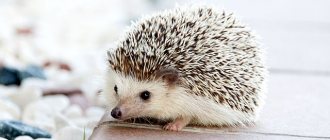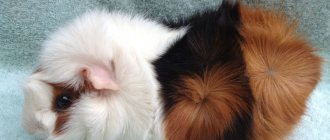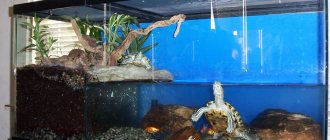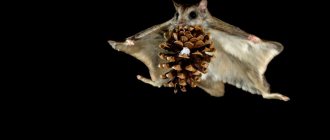Habitat in nature
As you can easily guess from the name, the homeland of the chameleon is Yemen and Saudi Arabia.
Although these countries are considered desert, chameleons live in coastal areas that regularly receive heavy rainfall and in drier valleys, but with plenty of greenery and water. Also introduced and established on the island of Maui (Hawaii) and Florida. In the past, Yemen chameleons were rarely seen in captivity, as wild ones did not take well to even experienced terrarium keepers. However, over time, individuals bred in captivity were obtained that were much more adapted. So most of the Yemeni chameleons found on sale are locally bred.
How to keep it at home
Terrarium
The volume is at least 200 l, if there are two pets then 400 l. Height not less than 0.8 m, length and width not less than 0.4 m. Made of glass. There is bedding on the bottom.
The volume of the terrarium is at least 200 l, if there are two pets then 400 l
Different corners of the terrarium should have different temperatures. In one of them the temperature should reach 30-32 degrees, in the other at least 25 degrees. Such areas should be formed on branches, since reptiles are rarely on the ground.
It is worth placing an ultraviolet lamp in the terrarium to provide the animals with vitamin D3. It would be good if there was a small waterfall. If this is not possible, then the area is sprayed 2 times a day. The water must be clean and have a temperature above room temperature.
There should be holes on the ceiling and at the bottom of the side wall to create good ventilation.
Nutrition
Ideal food options include crickets, flies, grasshoppers, locusts, cockroaches, dragonflies and butterflies. All insects must be alive.
The food is placed in a feeder, greased with oil, so that the living creatures do not run away. The animal determines the amount of food itself. A person’s task is to provide it in abundance.
For young reptiles, special vitamin powders are added to their food, which are sold in pet stores. The animal is also offered fruits and green leaves. Under no circumstances should you feed your chameleon juices from bags.
Ideal food options include crickets, flies, grasshoppers, locusts, cockroaches
Cleaning
Daily washing of the feeder and removal of waste products. Once a week, the terrarium is completely washed: the bedding is changed, disinfection is carried out, and all dust and dirt are removed.
It is better to place the reptile in another container while cleaning.
Walks
Some people like to be walked and enjoy sunbathing.
Rules of communication
The reptile does not need any special need for communication. Some people love to be held.
Diseases and treatment
- dehydration: wrinkles on the skin, drooping eyes, weight loss, sticky saliva. Treatment: drink from a pipette several times a day, show it to a specialist;
- rickets: curvature of the joints, deformed ridge, soft lower jaw. Treatment: give calcium;
- incomplete shedding: patches of white skin that remain after shedding. Treatment: supply of vitamin A, non-compliance with humidity standards;
- respiratory infections: weakness, heavy sighs, poor appetite. Treatment: maintaining optimal temperature in the terrarium, treatment with antibiotics.
Chameleons are sold in specialized stores. Their cost varies from 3,000 to 35,000 rubles.
In nature, the chameleon feeds on crickets, small rodents and reptiles, fruits, vegetables and tree leaves.
The diet at home should not be much different. You need to feed your chameleon twice a day. Crickets, beetles, butterflies, flies, cockroaches, and wax worms are suitable for a complete diet. As for fruits, the chameleon happily eats grapes, cherries, persimmons, and kiwi. Choose vegetables that are not hard; you can use green salad leaves and dandelions.
Of course, to keep this lizard you need to create conditions close to natural, and for this you will need a terrarium. The terrarium should be spacious, with a temperature of 28-32 degrees; install an ultraviolet lamp in it, which will maintain the temperature during the day, as we described, and 25 at night.
It is very important that the humidity in the terrarium is 60%, and for this, it is better to purchase a sprayer, a special pump, or regularly spray the lizard’s home yourself. Cover the bottom of the terrarium with sand, place as many branches and other vegetation as possible. Chameleons cannot drink from bowls, so they drink water dripping from leaves. If a chameleon becomes dehydrated, you will have to feed it with a syringe; you should not allow this to happen!
Care consists of two meals a day, regular spraying and periodic cleaning of the terrarium - all that is required of you.
The size of the terrarium can be 50 x 50 cm (width, length) and 120 cm in height. For females, a slightly smaller terrarium is suitable, but for a larger reptile it should be slightly larger.
In addition to temperature, it is important to observe the light regime - natural, artificial or combined. The duration of daylight should be at least 12 hours.
The diet of young chameleons consists of newborn or one-week-old crickets, which are sprinkled with a mixture of powder consisting of calcium phosphate and vitamins for reptiles, taken in the same proportion. They are fed 2 times a day; there should be enough food.
Exotic pets in city apartments are no longer such a rarity. We wrote about Achatina snails and tarantula spiders, but the real exotic in the house is the “earth lion,” as the ancient Greeks called the chameleon. The animals received this nickname for their special headdress, whose folds resemble a crown.
Even 20 centuries ago, this animal was a favorite of the Greeks and served as a kind of biological weapon against annoying insects. At that time, the contents of the chameleon were kept secret. Well, today we will reveal the secrets of communicating with a charming, but menacing-looking reptile.
Chameleons attract us, first of all, with their bright colors, which easily change to suit the environment, their funny tail, curled into a spiral, their curious way of moving, as well as their masterly use of a long tongue, thanks to which the pet is always full.
The most popular chameleons today are:
- Leopard chameleon
- Common chameleon and
- Yemen chameleon
The largest individuals of these species can reach 50-55 cm, the average ones - 25-30 cm, and finally, chameleons can be very tiny, up to 5 cm in length. Male chameleons are usually brighter and larger, their “horns” are more pronounced than those of females.
Most often, three types of chameleons are kept in terrariums: common, Yemen and leopard. They are not picky and do not require labor-intensive care. You can keep a female and a male: two males will fight almost to the death and divide the territory. The optimal size of the terrarium is from 150 liters (50x50x120 cm minimum, it depends on the size of the reptile).
Chameleons love warmth, the optimal temperature during the day is 30-32 degrees, at night - 22-24 degrees. The terrarium should be placed away from drafts and heating devices, in a well-ventilated room. You need two lamps: for lighting and sunbathing. The ultraviolet and fluorescent lamp (or incandescent lamp) must be kept out of reach, at a height of at least 35-40 centimeters from the reptile, otherwise the chameleon will get burned. The “home” must have a thermometer and thermostat.
Since these are still arboreal lizards, it would be good to plant plants in the terrarium and place branches and snags on which the pet can climb. Sphagnum, vermiculite, artificial turf, and coarse sand are used as bedding. Air humidity is approximately 60%; at least once a day, the plants and soil in the terrarium should be sprayed with clean water at room temperature. Daylight hours – at least 12 hours. In the warm season, you can take the cage outside or onto the balcony.
There should also be ventilation in the terrarium: lizards cannot be kept in tanks made of solid glass or plastic. It is also undesirable to use a metal mesh - the chameleon can injure its fingers. The best option is a terrarium with holes in the walls and ceiling or with a grate on top. Once every two weeks, the reptile’s home needs to be thoroughly cleaned, and it is not necessary to relocate the resident. Change bedding regularly, wash feeders and drinkers.
We invite you to read: Characteristics of the British Shorthair cat: playfulness, aggression, compatibility with children
Small chameleons are given food twice a day, adults – every other day. The lion's share of the diet is food of animal origin: flies, crickets, locusts, worms, tropical cockroaches, zoophobes and other insects. You can also give pieces of fruit (grapes, apples, bananas, citrus fruits), plant food.
The easiest way to feed insect chameleons is with tweezers: be careful, the lizard can swallow the tip of the tweezers along with the food and break its teeth. You can buy special tweezers with soft tips in pet stores. If a chameleon sticks its suction cup to the tweezers, do not make sudden movements; the tongue will come off on its own. You can put food in a feeder (made of glass or plastic, the walls are lubricated with oil so that the prey does not run away).
As for water, chameleons cannot drink from a regular drinking bowl; it is better to choose a drip one. You can also teach your pet to drink from a pipette or syringe without a needle. Lizards also lick dew from plant leaves, so spray the terrarium regularly and your pet will not be in danger of dehydration. As for mineral supplements, it can be chalk, crushed shells, vitamins and additives JBL, Tetra and others.
Despite their exotic appearance, chameleons quickly adapt, learn to sit in your arms, take food from you, and allow you to pet them. Such pets will bring you many pleasant moments and will also become the pride of your home.
This is a species of rather large lizard, growing 60 cm in length; males are not only larger in size than females, they are much brighter in color by nature. Color: green with yellow stripes on the sides, transverse orange stripes, and transverse brown stripes. The Yemen chameleon has a high crest on its head, which reaches a height of 7-8 cm, and is sometimes decorated with bright blue stripes.
These chameleons live exclusively in mountainous areas, for example, in Saudi Arabia and Yemen, hence the name of the lizard. Males of this species are very aggressive and often die in battle, but even aggression does not frighten us, and we clearly want to buy a chameleon in our home. How to keep a Yemeni chameleon, what to feed, how it changes color and how long it lives are the topics of our article.
A chameleon changes its color based on its environment or its own mood. The lizard changes color if it is sick, frightened, and even during the breeding season. Of course, this depends on the time of day, temperature, and humidity. They are able to change color during periods of starvation, dehydration, or danger, thereby giving a signal to their relatives.
The Yemen chameleon lives in nature from 3 to 5 years, but with proper care and diet, at home, its life expectancy is on average 7 years. So, it all depends on you! Of course, before buying, you need to immediately make sure that the lizard is not sick, and you should also know how many months or years old it is, this directly determines how long your pet will live, buy a healthy and newborn one.
Description, size, life expectancy
Adult males reach from 45 to 60 cm, females are smaller, about 35 cm, but with a fuller body. Both the female and the male have a crest on their head that grows up to 6 cm. Young Yemen chameleons are green in color, and as they mature, they develop stripes. Females can change color during pregnancy, both sexes during stress.
Coloring can vary depending on different conditions, for example, social status. The experiment showed that young Yemen chameleons raised alone were paler and darker in color than those raised together.
Healthy and kept in good conditions live from 6 to 8 years, with females being smaller, from 4 to 6 years. This difference is explained by the fact that females carry eggs (even without being fertilized, like chickens), and this takes a lot of energy and wears them out.
Important rules for keeping a chameleon
When accepting an exotic pet into your family, it is necessary to create natural living conditions for the animal that will be as close to natural as possible. A large vertical terrarium with a capacity of 200 liters is suitable for this purpose.
You will also need a heater that will allow you to maintain a temperature in the terrarium of at least 28-30 degrees, and a humidifier. The humidity in the chameleon's home should be about 70%.
A small pet needs ultraviolet radiation to feel good. Buy a UV lamp.
In order for the chameleon’s room to be well ventilated, it is necessary to cover one wall with a metal mesh.
Well, in the terrarium itself you should place an artificial pond and/or fountain, live plants, and strengthen the branches. A chameleon should feel as comfortable as possible in captivity.
FOOD, MAINTENANCE AND CARE OF THE YEMEN CHAMELEON AT HOME
The Yemen chameleon must be kept alone until it reaches sexual maturity (8-10 months) to avoid stress and fighting. They are very territorial and will not tolerate neighbors and two males will never get along in the same terrarium.
For maintenance you need a vertical terrarium, preferably with one wall in the form of a mesh or with ventilation holes covered with mesh.
The fact is that they need good ventilation, and this is difficult to do in a glass terrarium. Stagnant air leads to respiratory diseases.
Size? The bigger the better, do not forget that the male can reach up to 60 cm. A meter long, 80 cm high and 40 wide, this is the normal size. For a female, you can use a little less, but again, it won’t be superfluous.
If you bought a baby, then immediately prepare for moving in the future. It is an extremely common belief that if an animal lives in a small space, then it does not grow. This is a harmful, dangerous myth - it is growing, but it is sick and suffering.
The inside of the terrarium needs to be decorated with branches, vines, and plants so that the chameleon can hide in them. It is important that the structure is reliable and goes to a height where the chameleon will bask, rest, and hide. To do this, you can use both artificial and live plants - ficus, hibiscus, dracaena and others. In addition, live plants help maintain moisture balance and decorate the terrarium.
It is better not to use any soil at all in the terrarium. It can retain moisture, insects can hide in it, and a reptile can accidentally swallow it. The easiest way is to put a layer of paper on the bottom, and it’s easy to remove and don’t mind throwing it away. If this option does not suit you, then a special mat for reptiles will do.
Maintenance and care
It has been proven that chameleons need to be kept alone at home after they reach sexual maturity (about 8 months). If you leave his neighbors at home, he will not be able to avoid fights. These reptiles are very jealous of their territory, so they cannot stand being next to each other, especially if two males are placed in one terrarium.
Requirements for the terrarium:
- Vertical position;
- The presence of mesh or powerful ventilation on one side;
- Size (L*H*W): 1*0.8*0.4 meters;
- The presence of plants, branches, snags.
Both artificial and live greenery can be used as plants. A chameleon needs shelter even at home. There he can allow himself to warm up, rest or hide.
Many people mistakenly believe that the presence of soil is necessary. In fact, moisture lingers there and insects hide. In addition, the reptile may accidentally eat it. One convenient way is to put paper sheets on the bottom. They are not difficult to clean and are not expensive. There are small mats for reptiles in stores.
For good and proper care you need two lamps:
- Upper lamp for solar treatments and body heating;
- UV lamp for calcium absorption.
The lamps must be turned on 12 hours a day. Pay attention to the recommended duration of use of the ultraviolet lamp. After this period, the necessary UV spectrum is not released, which will lead to a deficiency of minerals.
All reptiles are cold-blooded, so they can regulate their body temperature only based on environmental conditions, even at home. The temperature in the terrarium should vary from 27 to 29 degrees without a lamp, and with a lamp from 32 to 35. Leave a little space at home where the pet can hide from the heat of the lamp, then he will make his own choice about the comfort of his stay. If possible, purchase a thermostat to avoid accidentally burning the animal or boiling it alive. In a natural environment, the temperature does not drop below 17-18 degrees at night.
Lighting and heating
The Yemen chameleon terrarium must be illuminated with two types of lamps for 12 hours. The first is heat lamps so they can bask under them and regulate their body temperature. Bottom heating, heated rocks and other heat sources are unfamiliar to them, so you need to use special reptile lamps.
The second lamp is an ultraviolet lamp, it is needed so that the chameleon can properly absorb calcium. In nature, it has enough solar spectrum, but in captivity, and even in our latitudes, it does not.
But, remember that the UV spectrum is filtered by ordinary glass, so the lamp must be placed in an open corner. And they need to be changed according to the manufacturer’s recommendations, even if they still shine. They no longer provide the required amount of UV rays due to phosphor burnout.
Like all reptiles, the Yemen chameleon regulates its body temperature depending on its external environment. The average temperature in the terrarium should be between 27-29 degrees. In the heating area, under the lamps, it is about 32-35 degrees. This way you will get a heating point and cooler places, and the chameleon will already choose where it is most comfortable at the moment.
We suggest you read: Raising sheep at home – Agricultural portal || Sheep farming at home necessary equipment
In nature, the temperature drops at night, so additional heating is not needed at this time. But only on condition that it does not fall below 17 degrees and in the morning he can warm up under a lamp.
Yemen chameleon (Chamaeleon calyptratus)
It is also called the helmet-bearing one; it received this name because of the expressive helmet adorning its head. The Yemeni chameleon is distinguished by its calm disposition, large size, bright color, and unpretentiousness in maintenance, which has gained universal love for keeping this species, both beginners and experienced terrarium keepers .
This chameleon got its name from the state of Yemen, which is their habitat. Leads an arboreal lifestyle, occupying various shrubs and trees in arid desert and semi-desert biotopes. Each chameleon adheres to a territorial area. It uses foliage and branches of bushes and trees as shelters; its natural ability to mimicry helps it in this. One of the largest representatives of this species. Males reach 60 cm in length, and females about 40. They are very brightly colored, there are yellow-brown stripes on the dark green body, the male’s head is decorated with a high crest, females, compared to the male, have a calmer color. Life expectancy in nature is 2-3 years, in captivity with good maintenance 4-5 years, there have been cases when a chameleon lived up to 6 years.
A chameleon needs a vertical terrarium with good ventilation. Size for one individual is 40x40x60. For a couple, the volume of the terrarium should be increased by 1.5 times. In most cases, chameleons are kept alone, since when kept together, the lizards are stressed. Usually chameleons are kept only for the mating period. In the event that you still want to keep a couple, you should get a couple of terrariums. In nature, a chameleon drinks by licking droplets of water from the leaves, so spraying the terrarium is necessary to provide it with drinking water. You can also install a dropper in the terrarium, set to infrequent dripping, or you can additionally solder the chameleon from a syringe.
It is necessary to place driftwood in the terrarium, which is best placed diagonally so that the top point is 20 cm from the heating lamp.
The terrarium must be equipped with two lamps: incandescent and with a UV spectrum. It is best to install a heating lamp outside the terrarium, as the chameleon can get burned. A UV lamp is needed especially during the growth period to avoid the development of rickets. For the same purpose, it is necessary to give dry vitamins and minerals such as RertiCalcium two to three times a week, sprinkling them on the fed insects. Liquid vitamins such as Reptosol are given orally, one to two drops once a week. The chameleon feeds on insects: crickets, cockroaches; in small quantities you can offer zofobas and mealworms. An adult chameleon eats 3-4 times a week, juveniles eat daily with the addition of vitamins.
Most often, young individuals are found on sale. It is best to buy a lizard that has reached three months of age, since without proper experience it is difficult to raise a chameleon. The chameleon grows very quickly; already at the age of five months it has an impressive appearance and size.
The background temperature in the terrarium should be 25-27 degrees, in the heating zone 35-40, at night the temperature can be lowered to 22 degrees.
The chameleon has a calm disposition, so you can handle it without fear.
If you follow these simple recommendations for keeping this species, you will be the owner of a luxurious chameleon that will surprise and delight you and your loved ones.
Basics:
1. terrarium type 3 (Vertical)
2. the presence of heating lamps and UV spectrum in the terrarium
3. spray twice a day
4. feeding three times a week, type of food insects
5. vitaminization - once a week
Types of chameleons for home keeping
Diseases and treatment
This is a species of rather large lizard, growing 60 cm in length; males are not only larger in size than females, they are much brighter in color by nature. Color: green with yellow stripes on the sides, transverse orange stripes, and transverse brown stripes. The Yemen chameleon has a high crest on its head, which reaches a height of 7-8 cm, and is sometimes decorated with bright blue stripes.
These chameleons live exclusively in mountainous areas, for example, in Saudi Arabia and Yemen, hence the name of the lizard. Males of this species are very aggressive and often die in battle, but even aggression does not frighten us, and we clearly want to buy a chameleon in our home. How to keep a Yemeni chameleon, what to feed, how it changes color and how long it lives are the topics of our article.
The chameleon changes its color based on its environment or its own mood. The lizard changes color if it is sick, frightened, and even during the breeding season. Of course, this depends on the time of day, temperature, and humidity. They are able to change color during periods of starvation, dehydration, or danger, thereby giving a signal to their relatives.
The Yemen chameleon lives in nature from 3 to 5 years, but with proper care and diet, at home, its life expectancy is on average 7 years. So, it all depends on you! Of course, before buying, you need to immediately make sure that the lizard is not sick, and you should also know how many months or years old it is, this directly determines how long your pet will live, buy a healthy and newborn one.
What to feed a chameleon? This is one of the important issues that future owners of an exotic pet must resolve.
The chameleon's menu may include:
- Locust
- Mealworms
- Crickets
- flies
- Small mammals
- Zoophobes
- Little lizards
But, despite the habits of the predator, the pet is happy to enjoy pieces of fruit: citrus fruits, bananas, apples, grapes.
The water regime must be given special attention. The fact is that, unlike many other animals, chameleons do not know how to drink and lap from drinking bowls and bowls. In nature, these animals drink droplets of water that collect on the leaves of plants and flow down from the leaves. To prevent your pet from feeling thirsty, spray the terrarium plants with water more often.
It’s good if the terrarium is spacious. Then, at its different levels, the animal will find the most comfortable place for itself. Inside, decorate your reptile's room with potted plants. You can put treated driftwood on which the chameleon will climb. He also needs a small pond, take care of that too.
It is also necessary to make a small pump inside the terrarium, which will create a stream of supply water. After all, these reptiles in the wild drink water only from the leaves of plants, which lies on them in droplets.
In the summer, during the daytime, take the cage with the adult reptile outside. The reptile will happily feast on flying insects. To attract them, you can place rotten fruits next to the enclosure. If the nights are warm, you can leave the chameleon's cage outside or keep the animal in an outdoor enclosure during this time. Of course, it is necessary that it have a roof that would protect it from precipitation.
To prevent young chameleons from becoming dehydrated (which they are susceptible to), mist the terrarium with water twice or thrice a day.
Adults are fed from a feeder or tweezers with large crickets, tropical cockroaches, and are offered fruits and the fleshy leaves of some indoor plants, which they eat with pleasure.
A low plastic or glass container is suitable for the feeder. Its inner walls are lubricated with vegetable oil to prevent insects from scattering.
Chameleons do not know how to drink from a container, so if you cannot make a pump, try teaching them to drink from a syringe with a blunt needle or from a pipette. If this does not work, squirt small doses of water into the chameleons’ mouths when they open it.
These lizards, in addition to water, can drink juices. Prepare a honey solution for them, which the animals will also like.
If you follow the recommendations listed above, the chameleon will live with you for at least four years and delight the owner and his family throughout this time with its charming appearance and funny habits.
Chameleon nutrition
The diet of young chameleons consists of newborn or one-week-old crickets, which are sprinkled with a mixture of powder consisting of calcium phosphate and vitamins for reptiles, taken in the same proportion. They are fed 2 times a day; there should be enough food.
To prevent young chameleons from becoming dehydrated (which they are susceptible to), mist the terrarium with water twice or thrice a day.
Adults are fed from a feeder or tweezers with large crickets, tropical cockroaches, and are offered fruits and the fleshy leaves of some indoor plants, which they eat with pleasure.
A low plastic or glass container is suitable for the feeder. Its inner walls are lubricated with vegetable oil to prevent insects from scattering.
Chameleons do not know how to drink from a container , so if you cannot make a pump, try teaching them to drink from a syringe with a blunt needle or from a pipette. If this does not work, squirt small doses of water into the chameleons’ mouths when they open it.
These lizards, in addition to water, can drink juices. Prepare a honey solution for them, which the animals will also like.
If you follow the recommendations listed above, the chameleon will live with you for at least four years and delight the owner and his family throughout this time with its charming appearance and funny habits.
Leave your comments and ask questions.
Don't make the cat angry!
Drink
Being arboreal dwellers, Yemen chameleons usually do not recognize drinking bowls. They simply do not notice them, since in nature they drink morning dew and drops during rain. So it is important to mist the terrarium twice a day with a spray bottle for about two minutes.
You need to spray the branches and decor, and the chameleon will pick up the drops falling from them. You can also purchase a system that periodically releases drops of water onto the leaves underneath. The humidity in the terrarium should be moderate, about 50%.
Feeding and care
Caring for a chameleon consists not only of organizing a place to stay at home, but also of proper feeding and nutrition. The difficulty in creating a drinking regime lies in the fact that tree dwellers do not recognize drinking bowls and drinkers. In their natural environment, they collect morning dew from the leaves, so you will have to create a similar atmosphere at home. To do this, generously spray the plants and decor with a spray bottle for a couple of minutes. The chameleon will collect the drops rolling off the decor. Modern pet stores offer an excellent solution to this problem by selling a device that independently sprays water after a certain period of time. For proper care, humidity should be about 50%.
Suitable for feeding:
- earthworms,
- grasshoppers,
- flies
- Little mice,
- Locust,
- cockroaches,
- Plant foods (dandelion leaves, peppers, zucchini, apples and pears),
- Cicadas.
Do not forget about microelements that chameleons do not receive, even if you take care of them according to the first level. Therefore, be sure to include mineral supplements and vitamins in your diet. Pregnant females and young animals need an additional dose of calcium-containing supplements. All dietary supplements are given at least 2 times a week.
Feeding
The basis of feeding can be crickets, no larger in size than the distance between the eyes of a chameleon. Juveniles and juveniles should eat once or twice a day, preferably having access to food at any time. As they grow, the frequency of feeding is reduced, but adults are fed once every two days.
It is important to provide additional calcium and vitamins so that the animal grows healthy. This is especially important for pregnant females and juveniles. Treat the food with special additives (calcium, vitamins and others you can find in pet stores) two to three times a week.
In addition to crickets, they eat locusts, cicadas, flies, grasshoppers, earthworms, and cockroaches. Also, adult chameleons can eat naked mice and plant foods. Plant foods are important; they can be hung in the terrarium or given from tweezers. They prefer juicy fruits and vegetables: dandelion leaves, zucchini, peppers, apple slices, pears.
What and how to feed
Nutrition
Insects such as earthworms, grasshoppers, flies, locusts, and cockroaches are suitable as food. From the world of flora, dandelions are good. You need to add vegetables (peppers and zucchini) and fruits (apples, pears, bananas) to your diet.
Vitamins
No matter how balanced your animals eat, they will still not receive the amount of microelements they naturally need at home. Therefore, you should try to introduce dietary supplements and vitamins into complementary foods 2 times a week.
Drink
For chameleons , water is of great importance; it should always be available . But a small catch is that reptiles do not recognize any sippy cups or bowls. In the natural environment, they get drunk with dew.
To create a similar atmosphere, you need to spray the plants and decor inside the terrarium for a few minutes.
Important! Specialized pet stores offer for sale special devices that spray water themselves after a certain period of time.
The nuances of keeping chameleons
Remember that chameleons are nervous animals, do not provoke your pet’s excitement. Remember, any stress is harmful to your pet's health.
Put your hands in the terrarium as often as possible. The chameleon needs to get used to your smell, understand and accept that your hands are not dangerous and will not harm him.
The terrarium is intended for one individual only. If you add a neighbor to your chameleon, this may have a negative impact on one of the animals. If you are adopting a chameleon for the first time, choose a male.
Of course, chameleons are very interesting animals, each with their own characteristics, character and habits. But once you make friends, you will understand how affectionate and gentle this exotic pet can be. The most important thing is to give him the necessary attention, care and respect. You can buy everything you need to keep a chameleon in your home at any Zoogalereya retail store.
Breeding
They become sexually mature at the age of 9-12 months. If you place a suitable partner with them, then it is quite possible to get offspring. Usually, a planted female causes activity and mating games in the male, but you need to make sure that there is no aggression.
If the female is ready, she will allow the male to court her and mate. They can mate several times until the color changes to dark, indicating that she is pregnant. The dark color of the female is a signal to the male that he should not touch her. And she becomes very aggressive at this time.
After about a month, the female will begin to look for a place where she will lay eggs. She sinks to the bottom of the terrarium and looks for a place to burrow. As soon as you notice this, add a container of moist vermiculite or fiber to the terrarium.
We invite you to familiarize yourself with: Keeping ducklings of the Bashkir breed
The mixture should allow the female to dig a hole without crumbling. Moreover, the container should be large enough, at least 30 by 30 cm. The female can lay up to 85 eggs.
They will incubate at 27-28 degrees for 5 to 10 months. You can transfer the eggs to an incubator, where it will be easier to monitor them and remove unfertilized ones.
Which chameleon is suitable for keeping at home?
These lizards can live in an ordinary apartment, in a terrarium. But you need to know the conditions of keeping a chameleon, then the lizard will be comfortable in captivity.
- Calcarifer lives in the eastern part of Saudi Arabia, so is used to being in a hot and dry climate.
These species are also not picky and less demanding on living conditions.
If you keep young chameleons together, place plants in the terrarium that will form dense thickets so that each lizard lives in its own territory and thus avoid conflicts.
- Read about Virgin Star cream-gel for vaginal tightening
- How to lose 20 kg - real reviews on Guarchibao
Many of the species are able to live only in nature.
There are three types that you can keep at home:
- Yemeni: reach up to 60 cm in length. The body is green with yellow spots. There is a crest on the head up to 8 cm. The lifespan of males is 8 years, that of females is one and a half times less.
- Leopard: males grow up to 50 cm in length, females - up to 35 cm. All are approximately 180 g. There are transverse stripes on the body. Life expectancy is about 4 years.
- Common: grows up to 30 cm in length. Colors: yellowish, brown, green. Life expectancy is about 4 years.
Yemen Chameleon
If you want a nice large reptile to live in your home, then the Yemen Chameleon (pictured above) is suitable. This is a fairly hardy reptile that adapts well to new living and keeping conditions and tolerates changes in humidity and temperature. The price of such a reptile is about 700–1000 UAH. in Ukraine and 1500–3000 rubles in Russia.
In the wild, this type of chameleon lives in hot countries - in Saudi Arabia, Yemen and comes in two types:
- Calcarifer lives in the eastern part of Saudi Arabia, so is used to being in a hot and dry climate.
- Calyptratus lives in the north of the country, where it is slightly cooler. Therefore, he will feel good at home in a terrarium, where the daytime temperature is 30°C or slightly higher, and the night temperature is about 20°C. This type of chameleon has richer colors and is larger in size than Calcarifer; it can grow up to 60 cm in length.
- Ordinary;
- Leopard print.
With good care, the lizard will live with you for 4 years, and the Yemeni chameleon may well bear offspring, for this you need to purchase a male and a female. But two males cannot be placed in the same terrarium, as they will fight to defend the rights to the female, and in doing so they can injure each other.
If you keep young chameleons together, place plants in the terrarium that will form dense thickets so that each lizard lives in its own territory and thus avoid conflicts.
This question is very important. After reading this section, you will learn how to choose a chameleon so that it is healthy.
- Firstly, do not buy lizards secondhand. Purchase from a specialized store, where they will provide you with the necessary documents.
- Secondly, do not buy very small lizards. Birth defects may not appear immediately, but are usually noticeable by four months. Therefore, it is better to buy a chameleon that is already 4 months old.
- Examine his eyes; they should be open and moving. If they are sunken, then the chameleon is severely dehydrated; if they are closed, then the animal is exhausted.
- Look what color it is. The animal's illness will be indicated by gray or dull skin color. This may also be due to the low temperature in which the lizard is kept.
- The chameleon's paws will also tell you about the condition of the animal. They should be smooth, and the reptile itself should be mobile. If it is clear that it has difficulty moving, it means that its musculoskeletal system is impaired or there is a lack of calcium.
- Look at the chameleon's slightly open mouth. For him to open it, take the lizard in your hands, then it will hiss, and you can see if there are yellow-green spots in the reptile’s mouth. Their presence indicates the presence of an inflammatory process in the reptile.
The temperature inside the terrarium during the daytime should not fall below 28°C, optimally 30? 32 °C. Night temperature should be 22? 24°C, so place the animal’s house in a warm place where there are no drafts - they are very dangerous for the lizard.
In addition to temperature, it is important to observe the light regime - natural, artificial or combined. The duration of daylight should be at least 12 hours.
Chameleons do not know how to drink from a container, so if you cannot make a pump, try teaching them to drink from a syringe with a blunt needle or from a pipette. If this does not work, squirt small doses of water into the chameleons’ mouths when they open it.
Video about caring for a pet chameleon, tips.
So, you want to get yourself a chameleon? Chameleons make wonderful pets, but you will need to provide them with some necessary conditions to keep them happy and healthy. Find out which type you should buy and how to care for it.
If you want a cute, large-sized reptile to live in your home, the Yemeni chameleon (pictured above) is a good choice. This is a fairly hardy reptile that adapts well to new living and keeping conditions and tolerates changes in humidity and temperature. The price of such a reptile is about 700–1000 UAH. in Ukraine and 1500–3000 rubles in Russia.
In the wild, this type of chameleon lives in hot countries - in Saudi Arabia, Yemen and comes in two types:
- Calcarifer lives in the eastern part of Saudi Arabia, so is used to being in a hot and dry climate.
- Calyptratus lives in the north of the country, where it is slightly cooler. Therefore, he will feel good at home in a terrarium where the daytime temperature is 30°C or slightly higher, and the night temperature is about 20°C. This type of chameleon has richer colors and is larger in size than Calcarifer; it can grow up to 60 cm in length.
If you keep young chameleons together, place plants in the terrarium that will form dense thickets so that each lizard lives in its own territory and thus avoid conflicts.
How to choose the right chameleon
This question is very important. After reading this section, you will learn how to choose a chameleon so that it is healthy.
- Firstly, do not buy lizards secondhand. Purchase from a specialized store, where they will provide you with the necessary documents.
- Secondly, do not buy very small lizards. Birth defects may not appear immediately, but are usually noticeable by four months. Therefore, it is better to buy a chameleon that is already 4 months old.
Here's what is important to pay attention to when examining your future pet:
- Examine his eyes; they should be open and moving. If they are sunken, then the chameleon is severely dehydrated; if they are closed, then the animal is exhausted.
- Look what color it is. The animal's illness will be indicated by gray or dull skin color. This may also be due to the low temperature in which the lizard is kept.
- The chameleon's paws will also tell you about the condition of the animal. They should be smooth, and the reptile itself should be mobile. If it is clear that it has difficulty moving, it means that its musculoskeletal system is impaired or there is a lack of calcium.
- Look at the chameleon's slightly open mouth. For him to open it, take the lizard in your hands, then it will hiss, and you can see if there are yellow-green spots in the reptile’s mouth. Their presence indicates the presence of an inflammatory process in the reptile.











